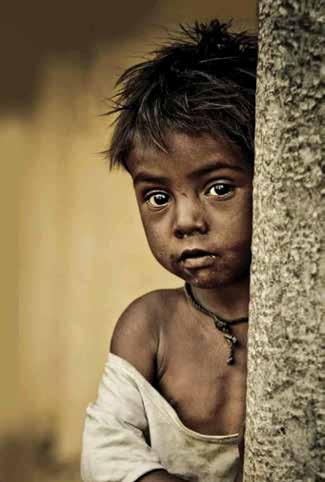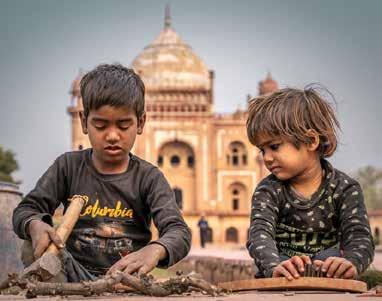
7 minute read
Poorest Countries 10 of the world where fighting for tummy is more than arms
Studying The Richest Nations Of The Globe Can Be Glamorous And
Aspirational, But It’s Also Crucial To Be Aware Of Those At The Opposite End Of The Wealth Distribution.
Advertisement
One of the main strategies used by organisations like the UN to enhance the general standard of living for the residents of poorer countries is to assist those nations in strengthening their financial positions. The natural resources, educational system, political stability, and national debt of a country are only a few of the many elements that affect wealth.
Although not all, the majority of the world’s poorest nations are also among the least developed, commonly referred to as third world countries or, less generously, as undeveloped countries.

Poorest nations
In the four-tiered World Bank rating system, the poorest nations in the world are categorised as low-income economies. The gross national income (GNI) per capita for each nation, which is the total national income divided by the population, is the basis for this ranking. Gross Domestic Product (GDP) per capita and GNI are extremely similar. Both measurements calculate the total dollar worth of all products made in a nation, while GNI additionally incorporates revenue from overseas sources (such as foreign investments or real estate holdings). Because of this, GNI is regarded as a marginally more accurate indicator of a nation’s economic health.
The riches and resources of the world are sufficient to guarantee that everyone has access to a minimal quality of living. However, people in the three most impoverished nations in the world— Burundi, South Sudan, and the Central African Republic— continue to live in abject poverty. Other obvious candidates for the unfavourable distinction of being the poorest of the poor, such as Afghanistan, Syria, and Lebanon, have endured years of military, social, and political unrest, making any judgement impossible due to the dearth of accurate economic data.
But how do we gauge one country’s richness or poverty in relation to another?
While GDP per capita is frequently regarded as the benchmark indicator, the purchasing power parity (PPP), which accounts for variations in living expenses and inflation rates, might provide a more accurate picture. Taking the same benchmark, here, we put some light on the poorest countries in the world.
10. Democratic Republic of the Congo: per capita income 2020- $550
The Congo has endured decades of violent rule, political instability, and unrelenting conflict since obtaining independence from Belgium in 1960. After Félix Antoine Tshisekedi Tshilombo, the son of eminent opposition leader Etienne Tshisekedi, was elected president in 2019, the nation turned to a new path. He has challenging duties ahead of him. The controversial Joseph Kabila, who had been president since taking over for his murdered father in 2001, is credited with putting a stop to the
“Great African War,” which is thought to have resulted in up to 6 million deaths, either directly from warfare or from illness and starvation. He did little, nevertheless, to enhance the lives of those who had survived the conflict. Contrarily, a new financial record leak demonstrates how, while in office, he utilised a private bank to syphon off nearly $138 million in public cash. About 75 percent of the 90 million people who live in the nation still make less than $2 each day.
9. Niger: per capita income 2020- $540
Niger tops the UN’s human development report as the world’s poorest nation thanks to factors including a GNI per capita of $540, a life expectancy of 60.4 years, and a mean 2 years of education (as opposed to an expected 5.4). According to World Bank statistics from 2014, the country’s 21.5 million people, or 44.5% of the population, live in extreme poverty.
Concern, an NGO, has been working in Niger for 16 years, assisting communities as they face a slew of development issues aggravated by terrorist invasions, migration, climate change, and excessive population growth. Poverty manifests itself in Niger as high levels of food insecurity, illnesses such as chronic malaria, and limited access to utilities like as water and sanitation. Agriculture-related crises have exacerbated hunger and nutrition concerns that have afflicted much of the Nigerien population in the previous 20 years, risking the lives of millions of people. This has resulted in three significant crises in the recent decade.
7. Central African Republic: per capita income 2020- $510
Armed rebel groups are able to operate in the country and control substantial portions of the national territory because the Central African Republic has a weak central government. Additionally, the employment of Russian mercenaries by the government to keep the peace enrages Western nations. Due to ongoing conflict, Sub-Saharan Africa’s GDP growth for our estimate period of 2026 is anticipated to be significantly below average. In the future, it will be crucial to keep an eye on the development of a new constitution, which is expected to strengthen the president’s authority, as well as the adoption of bitcoin, which was recognised as legal cash earlier this year.
6. Afghanistan: per capita income 2020- $500

Afghanistan is still among the least developed nations in the world even though it has confirmed undiscovered mineral reserves worth over a trillion dollars. Over 23% of its workforce is unemployed, and nearly 50% of its people live in poverty. The primary cause of all of this has been the ongoing conflict in Afghanistan, which not only discourages significant foreign investment and assistance supplies but also has an adverse impact on public health across the board. Afghanistan has always looked for international investment to help its economy. The US Biden administration has blocked Afghanistan’s $9.5 billion worth of assets in order to further harm the country’s economy.
5. Sierra Leone: per capita income 2020- $490
In the middle of the 2010s, the Ebola virus rocked the economy, having an effect on employment and trade after a protracted civil war that concluded in 2002. This year’s import price spike due to the conflict in Ukraine has hurt consumers’ purchasing power and sparked violent anti-government rallies in August. A small export base, primarily made up of base metals, timber, diamonds, and cocoa, inadequate governance, and constrained fiscal space all restrain the economy. With growth projected to be only marginally above Sub-Saharan Africa’s average during the coming years, Sierra Leone will probably become the thirdpoorest nation in the world in 2026. The results of the elections in 2023 will be a crucial event to follow.
4. Madagascar: per capita income 2020- $480
Madagascar, the world’s fourth-largest island, sits 400 kilometres off the coast of East Africa. Despite being renowned for its
8. Liberia: per capita income 2020- $530 incredible wildlife, the country’s thriving tourism sector has not been able to help it escape poverty. The bulk of the population still relies on agriculture for a living, making the economy particularly vulnerable to natural disasters. Madagascar has gone through periods of political unrest, violent takeovers, and contentious elections since gaining independence from France in 1960. But in recent years, Madagascar finally appeared to be trending upward. Poverty reduction and infrastructure development were top priorities for President Andry Rajoelina and his predecessor (and rival) Hery Rajaonarimampianina. Growth was accelerating steadily, structural changes were being made, and returning foreign investors.
Liberia, the oldest country in Africa, was torn apart by civil wars from 1989 to 2003. Despite the fact that peace now outlasts conflict, the GNI per capita is only $530, and the average life expectancy is 63. The West African Ebola pandemic of 2014–16, which infected 10,675 Liberians and claimed 4,809 lives, also had a severe impact on Liberia. According to the World Bank’s most recent study of the nation, conducted in 2016, roughly 51% of the population was assessed to be living below the poverty line, leaving a lasting impact on the livelihoods of survivors. Even though 10 years of education are recommended, the average Liberian barely finishes 4.7 years of school. Concern has been involved in Liberia for 23 years, addressing the country’s severe poverty-related issues. This includes assisting with clean water projects to support the 42.5% of Liberians without access to protected wells, nutritional initiatives to counteract the 35.5% of children who are stunted, and projects against malaria and gender-based violence.
3. Mozambique: per capita income 2020- $460
The former Portuguese territory has an abundant amount of water and agricultural land, as well as an abundance of mineral and energy deposits. Mozambique is also strategically positioned, as four of its six borders are landlocked and rely on it as a conduit to global trade, and it has consistently posted average GDP growth rates of more than 7% over the last decade. Nonetheless, it remains one of the world’s top ten poorest countries, with huge segments of the population living considerably below the poverty line. While a 15-year civil conflict ended in 1992, severe weather, corruption, and political instability persisted. Making matters worse, since 2017, attacks by Islamic rebel groups have plagued the country’s gas-rich north, resulting in up to 4,000 fatalities and 800,000 displaced people.
2. Somalia: per capita income 2020- $310
Somalians are losing hope as a result of three decades of internal conflict and violence that have forced hundreds of thousands of people to flee their homes, as well as frequent droughts and floods that are followed by famine and disease, lack of access to health care, extremely high rates of unemployment among young people in particular. This 16-million-person nation on the Horn of Africa never seems to have a good day. The coronavirus pandemic, a locust infestation unheard of in modern times, and exacerbated flooding caused the economy to decline in 2020, interrupting the consistent GDP growth seen in the later part of the previous decade. Then, while a shaky recovery was taking hold, the boycott of Ukraine’s wheat exports further depressed the nation and crammed local hospitals with critically undernourished children.
1.Burundi: per capita income 2020- $270
The unenviable distinction of being the world’s poorest nation belongs to the small, landlocked nation of Burundi, which has been scarred by Hutu-Tutsi ethnic conflict and civil war. Food scarcity is a major issue in this country of nearly 12 million people because 90% of its population depends on subsistence agriculture (and the vast majority of them live in extreme poverty). The level of food insecurity is nearly twice as high as the average for subSaharan African nations.

Less than 5% of the population has access to electricity, and water and sanitary facilities are still in very short supply. It goes without saying that the pandemic and the conflict in Ukraine have only served to make all of these issues worse.
Despite the civil war having officially ended 15 years ago, how has it come to this situation? The factors that contribute to extreme poverty are frequently the typical aspects: a lack of infrastructure, widespread corruption, and security issues. Former Hutu rebel turned charismatic president Pierre Nkurunziza had originally succeeded in bringing the nation together behind him and in reviving the economy. But in 2015, his declaration that he would seek a third term— which the opposition claimed violated the constitution—rekindled old disagreements. Thereafter, there was an unsuccessful coup attempt, hundreds of clash-related fatalities, and tens of thousands of internal and external displacements.










